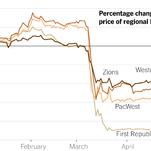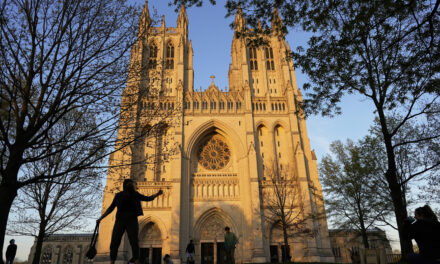
Smaller Banks Are Scrambling as Share Prices Plunge

Investors are not convinced that regional banks including PacWest and Western Alliance can remain viable. Some are actively betting on their demise.
Percentage change in regional bank stocks since the start of 2023
A cluster of regional banks scrambled on Thursday to convince the public of their financial soundness, even as their stock prices plunged and investors took bets on which might be the next to fall.
The tumult brought questions about the future of the lenders to the fore, suggesting a new phase in the crisis that began two months ago with the collapse of Silicon Valley Bank and Signature Bank, and was punctuated on Monday by the seizure and sale of First Republic Bank.
PacWest and Western Alliance were in the eye of the storm, despite the companies’ protestations that their finances were solid. PacWest’s shares lost 50 percent of their value on Thursday and Western Alliance fell 38 percent. Other midsize banks, including Zions and Comerica, also posted double-digit percentage declines.
On Friday, there were early signs of a potential rebound, as shares of PacWest and Western Alliance both rose about 12 percent in premarket trading.
Unlike the banks that failed after depositors rushed to pull their money out, the lenders now under pressure have reported relatively stable deposit bases and don’t sit on mountains of soured loans. They are also much smaller than Silicon Valley Bank and First Republic, which each had about $200 billion in assets when they collapsed. PacWest, based in Los Angeles, has about $40 billion in assets, and Western Alliance, with headquarters in Phoenix, has $65 billion in assets. Both banks run fewer than 100 branches.
The most immediate threat the banks face, analysts said, is a crisis of confidence. Headlines about their spiraling share prices could spook depositors and upend the banks’ ability to operate normally.
“How do we get out of this?” said Christopher McGratty, head of U.S. bank research at Keefe, Bruyette & Woods. “I think we’re still searching for that answer.”
Shares of PacWest and Western Alliance were halted for trading dozens of times on Thursday as their huge price swings breached stock-exchange guardrails put in place to prevent a sell-off from spiraling out of control. The turmoil also raised the specter of concerted action by short sellers, the traders who bet on share prices falling and are sometimes blamed for stoking market volatility.
The Biden administration was closely monitoring the markets, “including the short-selling pressures on healthy banks,” the White House press secretary, Karine Jean-Pierre, told reporters on Thursday. Gary Gensler, the chair of the Securities and Exchange Commission, said in a statement about market conditions that the agency was “focused on identifying and prosecuting any form of misconduct that might threaten investors, capital formation or the markets more broadly.”
Justin D’Ercole, a founder of ISO-mts Capital Management, a bank-focused fund, said the trading on Thursday felt “exceptionally panicky” and “overdone.”
“There was extreme anxiety about these banks without a lot of reasoning,” he said.
The trading was a reminder that the crisis may yet continue, belying predictions that the situation would be calmer after JPMorgan Chase came to an agreement with government officials to acquire the ailing First Republic.
Regulators agreed to assume billions of dollars of potential losses lurking on First Republic’s books, and JPMorgan’s chief executive, Jamie Dimon, declared immediately after the acquisition that “this part of the crisis is over.”
On Wednesday, the Federal Reserve chair, Jerome H. Powell, said during a news conference that conditions had calmed since Silicon Valley Bank’s collapse, noting that it and the two other failed banks “at the heart of the stress” had been resolved. Hours later, PacWest’s shares began their latest nosedive.
Image

It has since become clear that investors are not convinced that the regional lenders left standing can remain viable. And though there is no reason for any company to be immediately toppled by falling share prices, the outlook remains uncertain, with investors still bruised from March’s initial round of turbulence.
“Institutional investors have lost confidence in banks,” said Julian Wellesley, a bank analyst at Loomis Sayles. “I hear from a lot of people that the share prices don’t make sense but still no one wants to come in and buy.”
That’s disconcerting for the banks themselves, indicating that their claims of sound financial health have yet to achieve the desired impact.
There is a limit to how long any public company can limp along with a cratering stock price before creating fear among depositors and drawing ire from shareholders.
Even before this week’s commotion, depositors were increasingly worried about the safety of their money, following the collapse of Silicon Valley Bank. According to a Gallup poll conducted through late April, 48 percent of U.S. adults said they were concerned about the money they held in deposits at financial institutions.
The Federal Deposit Insurance Corporation, which guarantees bank accounts up to $250,000, this week released a report saying it would consider changes to its rules. The agency suggested that it might try to provide higher levels of insurance to business payment accounts, which would allow businesses to feel comfortable continuing to pay workers without creating the “moral hazard” problems that could happen if all deposits were broadly guaranteed.
It would require legislation from Congress to amend the current deposit insurance system.
Amid the relentless stock declines, some blamed a different boogeyman: Investors who bet on a fall in the price of a stock. Short sellers have made nearly $7 billion this year betting against regional banks, according to estimates by S3 Partners, a data provider, and can direct those profits toward new targets.
PacWest appeared most squarely in their cross hairs, for the moment at least. Almost 20 percent of the bank’s shares are currently on loan to short sellers, who sell them and hope to buy them back later when the stock has fallen, according to data from S3. Nearly 8 percent of Western Alliance’s shares are similarly lent out.
Before First Republic was seized, over 36 percent of its shares were out on loan.
On Thursday, Western Alliance blamed those short sellers for the turmoil, suggesting they were behind “false narratives about a financially sound and profitable bank,” as it issued a statement denying a report that it was considering a sale.
Such attacks rarely work against short sellers, and the banks’ disclosures, on Wednesday and Thursday, detailing that their depositors weren’t fleeing and that their capital base was sound, didn’t seem to either.
Image
One solution mooted to put an end to such attacks would be to ban short selling, which regulators did in 2008 as the financial crisis was erupting. It’s not clear whether such bans worked as intended and when asked about it on Thursday, a Securities and Exchange Commission spokesman said the agency was not contemplating any limits on short selling of regional bank stocks.
“I’m not sure just yet that Washington is going to do anything,” said Ian Katz, a policy analyst at advisory Capital Alpha Partners. He underlined the worry: “What is going to stop this at this point?”
In a display of confidence, executives at Zions, a Utah-based lender with about $90 billion in assets, spent nearly $2 million in the past several days investing in the bank’s falling stock, according to regulatory filings.
The lenders now under pressure also appear eager to open their books to try to reassure investors. First Republic mostly stayed quiet as its business collapsed.
PacWest released a statement overnight on Thursday saying that it had “been approached by several potential partners and investors.” Hours earlier, a report that it was exploring its options triggered a 50 percent slump in its share price in after-hours trading on Wednesday.
The bank said it had not seen “out of the ordinary” deposit outflows since First Republic’s collapse, saying that deposits stood at $28 billion as of Tuesday, down slightly from late April.
Western Alliance also released updated financial details on Wednesday and noted it “has not experienced unusual deposit flows” in recent days. It said deposits had increased by $1.2 billion since the end of March.
Western Alliance’s shares still whipsawed, particularly after The Financial Times reported that the bank had hired advisers to guide it on a potential sale — an indication that the lender was in need of help. The shares recovered from their worst losses after Western Alliance denied the report, but still ended the day significantly lower.
“The stock is not the company, and the company is not the stock,” said Timothy Coffey, a bank analyst at Janney Montgomery Scott. “But the loss of confidence in a financial institution can be hard to repair.”
Reporting was contributed by Jeanna Smialek, Alan Rappeport, Maureen Farrell, Stacy Cowley and Lauren Hirsch.
Source: https://www.nytimes.com/2023/05/04/business/regional-banks-stock-price-pacwest.html

















